Yoga Poses for Beginners
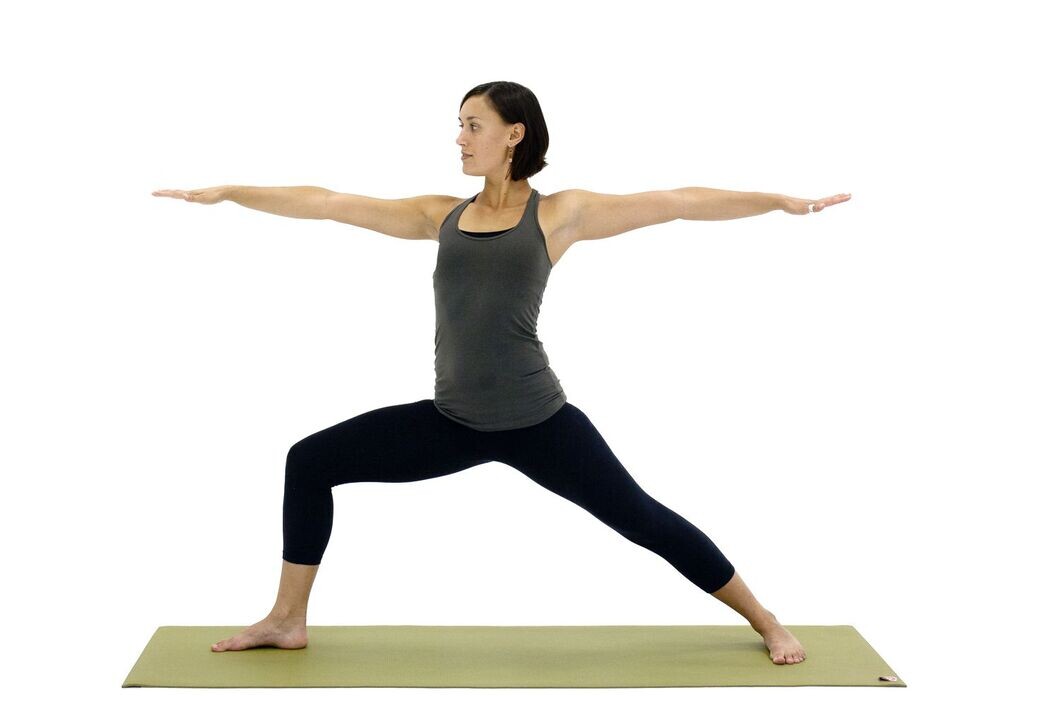
Hey there, aspiring yogis! Ready to dip your toes into the vibrant world of yoga? Welcome to a journey that's not just about poses but a happy exploration of your body and mind. Buckle up for a joyful ride through beginner-friendly yoga poses that'll leave you smiling from ear to ear. Whether you’re searching for a new chill-out hobby or dreaming of becoming as bendy as a rubber band, Everyday Yoga is here to kickstart your ‘om’-azing adventure with yoga poses perfect for beginners! No need to tie yourself into a human pretzel just yet—we’re all about those easy-breezy moves with a side of giggles.
Why Yoga's the Trendiest Ticket in Town?
Let’s be real, modern life can be a rollercoaster of to-dos and endless notifications needing your 👀. That's precisely why striking a yoga pose or two is like hitting the pause button on your very own remote control of zen. Yoga brings the chill vibes, the sweet stretches, and a bunch of health perks to make you sparkle inside and out—no previous experience required!
Here’s Your Yoga Starter Pack of Poses
Grab a mat (or a soft patch of carpet), comfortably stylish stretchy pants, and let’s flow through some beginner-friendly poses that'll have you feeling like a yoga rockstar in no time.
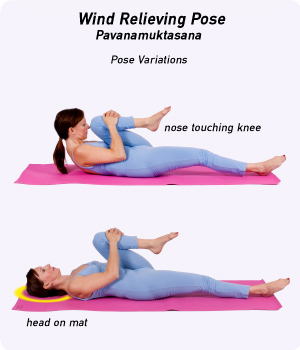
Also known as One-Legged Knee-to-Chest Pose, this moving posture (Pavanamuktasana) gently massages the abdominal organs, stimulating digestion, and releasing tension in the belly area. It also helps to release tension in the lower back, hips, and thighs.
- Begin by lying on your back, legs and arms extended.
- As you exhale, draw your knees to your chest. Clasp around them with your hands.
- Release your left leg and extend it along the floor, while still holding your right knee.
- Draw your left knee back in, then release and extend your right leg along the floor.
- Finally, draw both knees to your chest. With an exhalation, release and extend both legs along the floor and rest.
2. Cat-Cow Pose
Cat Pose is often paired with Cow Pose for a gentle warm-up sequence. Practiced together, the poses bring flexibility to the spine, stretch the back torso and neck, and softly stimulate the abdominal organs.
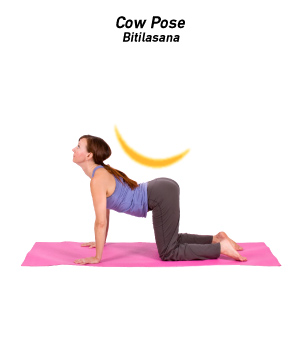
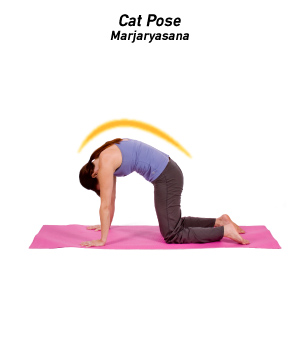
- Start on your hands and knees, with your wrists directly under your shoulders, and your knees directly under your hips. Point your fingertips to the top of your mat. Place your shins and knees hip-distance apart, center your head in a neutral position, and soften your gaze downward.
- Inhale as you drop your belly towards the mat, lift your chin and chest, and gaze up toward the ceiling. This is Cow Pose.
- As you exhale, draw your belly to your spine and round your back toward the ceiling. The pose should look like a cat stretching its back. Release the crown of your head toward the floor, but don't force your chin to your chest.
- Inhale, coming back into Cow Pose, then exhale as you return to Cat Pose.
- Repeat 5-20 times, then rest in Child's Pose (explained next).
3. Child's Pose
Often used as a resting position, Child's Pose (Balasana) helps to stretch the hips, thighs, and ankles while reducing stress and fatigue.

- Start on your hands and knees, then spread your knees wide while keeping your big toes touching.
- Exhale as you bow forward, letting your torso drape between your thighs.
- Keep your arms long and extended. Place your forehead on the floor. Then bring your arms to rest alongside your thighs, with your palms facing up.
- Come into Child's Pose whenever you need a break in your practice. Hold it for up to a minute or longer, breathing softly.
It might look like you're just standing there, but Mountain Pose (Tadasana) is an active pose that helps to improve posture, balance, and calm focus.

- Stand with your feet together, and your arms at your sides. Press your weight evenly across the balls and the arches of your feet. Breathe steadily and rhythmically. If you have trouble balancing, step your feet six inches apart (or wider).
- Straighten your legs, draw down through your heels, and ground your feet firmly into the earth. Draw the top of your thighs up and back.
- Tuck your tailbone slightly, but don't round your lower back. Keep your hips even with the center line of your body.
- As you inhale, elongate through your torso. Exhale and release your shoulder blades away from your head, toward the back of your waist.
- Broaden across your collarbone, keeping your shoulders in line with the sides of your body.
- Firm your shoulder blades toward the back ribs, but don't squeeze them together. Keep your arms straight, fingers extending, and triceps firm.
- Elongate your neck. Keep your breath smooth and even. Relax your gaze. Hold for up to one minute, then release into Uttanasana (explained next).
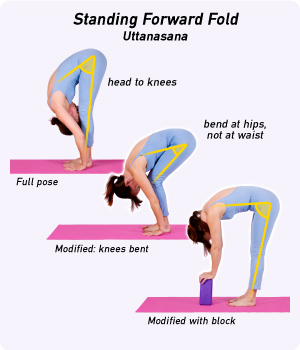
Standing Forward Fold (Uttanasana) combines the benefits of forward folds and inversions. Dropping your head below your heart calms your brain. This relieves stress, headaches, anxiety, fatigue, mild depression, and insomnia. Uttanasana also deeply stretches your hamstrings and calves.
- From Mountain Pose, exhale as you bend at the hips, lengthening the front of your torso.
- Clasp your elbows with your arms bent. Let the crown of your head hang down. Press your heels into the floor and lift your sit bones toward the ceiling. Turn the tops of your thighs slightly inward. Do not lock your knees.
- Lift and lengthen with each inhalation. Release deeper into the pose with each exhalation. Hold for up to one minute.
- To release, draw down through your tailbone as you inhale and come up to standing. Return to Tadasana. Repeat 5-10 times.
Twists are a great way to decompress. They squeeze out the anxiety and frustrations of your day like wringing out a sponge. They also stimulate and detoxify the organs of your torso.
.jpg)
- To begin, lie on your back with your knees bent, feet flat. You can rest your head on a pillow or blanket if your neck hurts. Extend your arms to the side, with your shoulder blades on the floor.
- As you exhale, drop your knees to the left as you gently turn your head to the right. Soften your gaze as you keep your shoulder blades pressing towards the floor and away from your ears. Allow the force of gravity to drop your knees even closer to the floor.
- Hold the pose for several breaths. Then on an inhalation, slowly bring your knees back to your chest. Exhale, and release your legs to the right.
- When you're finished with the pose, hug your knees to your chest for a few breaths, then slowly exhale as you extend your legs along the floor.
7. Corpse Pose
The final relaxation pose, Corpse Pose (Savasana) takes your yoga practice to a place where you can completely let go. Sometimes used to begin a practice, the pose is more commonly used to end practice to allow your body to fully relax and restore itself. Let lingering thoughts and worries fade away. From the depth and darkness of Savasana, you can be rejuvenated, refreshed, and reborn.
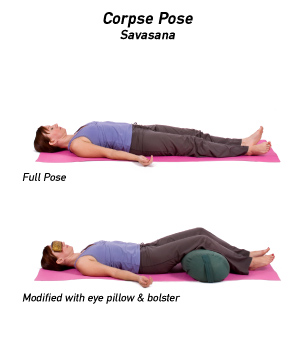
- Lie on your back and close your eyes. You may want to cover your body with a blanket.
- Allow your body to feel heavy on the ground. Let your legs and arms drop open.
- Working from the soles of your feet up to the crown of your head, release each body part, every organ, and every cell. Let your eyes close heavily. Invite deep peace and silence into your mind, body, and soul.
- Stay in Savasana for 5-15 minutes. Then deepen your breath, bringing gentle movement and awareness back to your body. Roll to your right side. With an inhalation, gently press yourself into a comfortable seated position. Take this peace you've created with you throughout the rest of your day.
But Wait, There's More—Yoga Breath & Easy
No yoga snack pack is complete without some delectable breathing exercises. Try some calming inhales and exhales to make those muscles mellow and that mind clear as a bell.
Roll up Your Sleeves!
As you venture into this magnificent world of mindful movement, remember there’s no rush, no competition, just pure enjoyment in the flow of yoga-tastic discovery. Stretch, smile, and let those positive vibes ripple out as you unfurl into your most vibrant self!
Got a favorite pose from your first yoga-tastic encounters? Maybe a laugh-out-loud moment when gravity won (it happens to the best of us)? Share the love in the comments, and let’s cheer on each other’s baby steps into the wide world of wellness. With Everyday Yoga, keep it light, keep it bright, and here’s to the beginning of your feel-awesome journey. Yoga-ho! 🌟🌈🧘♀️
See you on the mat!
Namaste!

